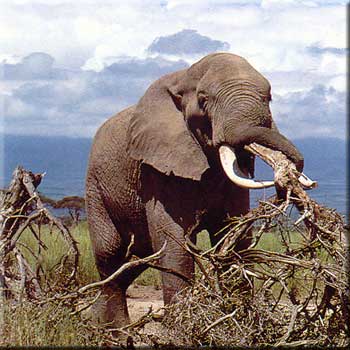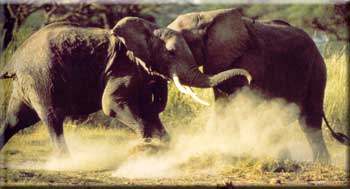|
The leadership
of a family herd always falls to an old and respected female called the
Matriarch. These herds usually consist of the female’s daughters and
granddaughters, and sometimes sisters and their offspring too.
The family
works in such a close way that they all take care of each other, to such
an extent that a female will often suckle another mother’s young.
The matriarch’s
role in the herd is so important that all of the rest of the herd look up
to her for everything. If the herd is threatened in any way it will be her
that instructs them to run or to form a defensive circle with the calves
safely inside. The adults at the front of the circle will spread their
ears as much as possible and hold their heads very high to increase their
size; this hopefully will intimidate their enemy into leaving them.
If one of the
herd becomes separated the group seems to become very anxious and make
long distance ‘contact rumbles’ to try to keep in contact. When this lost
soul returns to the heard she is greeted with much excitement. There is
much trumpeting, urinating, defecating and rumbling. The herd seems to
‘hug’ each other as they stand together in a tight circle with heads and
tails held high. This special greeting is only used for close relatives
and when two different families meet and greet each other this way, it
means that some of the older females are related. They would have grown up
together and have kept in touch over many years.
Apart from
humans, there are very few animals that have a social structure like this.
Adult Bulls are
not allowed to live within the herd, but when one of the females comes
into season (oestrus), they can be seen wandering the outskirts of the
herd giving male displays of strength and trying to get the female’s
attention.

Males
Once they reach
maturity bull elephants spend their time with other bulls or alone. They
do not form relationships with each other as the females do but loosely
associate with other males. Occasionally, it has been seen that a couple
of young males will attach themselves to a very old bull. The white
hunters called these old bulls ‘askaris’ which means soldier or guard. The
young bulls do benefit immensely by this association with the old tuskers
it seems. The bull passes on his ancient knowledge of how to survive
adverse conditions and the younger elephants gain knowledge of how
elephant society and politics work.
Male elephants
frequently spar, a trial of strength, to establish a hierarchy. It is the
bigger and stronger males who will mate with the females and these
sparring sessions confirm to the males who is to be respected.
The males do
remember each other, as the females do, and do not have to keep fighting
every time they meet to re-establish who is who.
In their mid
twenties the bulls experience the onset of musth when they begin to
challenge each other and they secrete from their temporal glands. They
hold their heads high, excrete very strong smelling urine and omit a very
low frequency musth rumble. This is the time when the males are ready to
mate. Unlike most of the year when the sparring is good-natured musth
bulls sometimes fight to the death. As they get older the musth season can
last a very long time and become more regular, a great strain on the
elephant because during this time he spends much less time feeding.

|